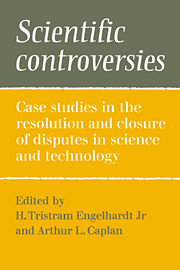 Scientific Controversies
Scientific Controversies Book contents
- Frontmatter
- Contents
- Preface
- List of contributors
- Introduction: Patterns of controversy and closure: the interplay of knowledge, values, and political forces
- PART I THEORETICAL PERSPECTIVES
- PART II CONTEMPORARY CASE STUDIES
- 12 Resolution of the Laetrile controversy: past attempts and future prospects
- 13 Federal regulation of Laetrile
- 14 Quasi libertarianism and the Laetrile controversy
- 15 Judicial deflection of scientific questions: pushing the Laetrile controversy toward medical closure
- 16 Politics, science, and the problem of psychiatric nomenclature: a case study of the American Psychiatric Association referendum on homosexuality
- 17 The diagnostic status of homosexuality in DSM-III: a reformulation of the issues
- 18 On arriving at the American Psychiatric Association decision on homosexuality
- 19 Values in the debate over workplace safety and health: the rancorous rhetoric about regulation
- 20 The successful experiment that failed
- 21 The power of efficiency: balancing benefits and costs in regulating occupational exposure to toxic substances
- 22 Closure in occupational safety and health: the benzene and cotton dust decisions
- 23 Nuclear fear: a history and an experiment
- 24 Closure and controversy: Three Mile Island
- 25 Understanding the nuclear power controversy
- PART III CONTROVERSY, CLOSURE, AND THE PUBLIC
- Author index
- Subject index
19 - Values in the debate over workplace safety and health: the rancorous rhetoric about regulation
Published online by Cambridge University Press: 03 February 2010
- Frontmatter
- Contents
- Preface
- List of contributors
- Introduction: Patterns of controversy and closure: the interplay of knowledge, values, and political forces
- PART I THEORETICAL PERSPECTIVES
- PART II CONTEMPORARY CASE STUDIES
- 12 Resolution of the Laetrile controversy: past attempts and future prospects
- 13 Federal regulation of Laetrile
- 14 Quasi libertarianism and the Laetrile controversy
- 15 Judicial deflection of scientific questions: pushing the Laetrile controversy toward medical closure
- 16 Politics, science, and the problem of psychiatric nomenclature: a case study of the American Psychiatric Association referendum on homosexuality
- 17 The diagnostic status of homosexuality in DSM-III: a reformulation of the issues
- 18 On arriving at the American Psychiatric Association decision on homosexuality
- 19 Values in the debate over workplace safety and health: the rancorous rhetoric about regulation
- 20 The successful experiment that failed
- 21 The power of efficiency: balancing benefits and costs in regulating occupational exposure to toxic substances
- 22 Closure in occupational safety and health: the benzene and cotton dust decisions
- 23 Nuclear fear: a history and an experiment
- 24 Closure and controversy: Three Mile Island
- 25 Understanding the nuclear power controversy
- PART III CONTROVERSY, CLOSURE, AND THE PUBLIC
- Author index
- Subject index
Summary
The Occupational Safety and Health Administration (OSHA) stands in the eye of the storm about government regulation. Mere mention of OSHA in many quarters triggers rancorous rhetoric, revealing underlying conflicts about the power relationships of labor and management, about social responsibility of corporations, about “internalizing” the costs of products and production, and about concepts of freedom in our society.
One of the more amusing political moments of 1980 was the Kissingerian negotiation at the Republican National Convention aimed at placing former President Ford on the ticket with Mr. Reagan. One wag, impressed with Kissinger's negotiating skills and with his chutzpah in agreeing with the television interviewers that Ford would be “co-President,” warned Reagan that by the time the areas of responsibility had been distributed, he – Reagan – might be left with “nothing but OSHA”! Dignified businessmen, upon joining a discussion about OSHA, are prone to begin talking about heights of toilet seats and spacing of rungs on ladders – as examples of the weighty matters that they think preoccupy OSHA inspectors. And the sagebrush conservatives who moved to Washington in 1981 love to describe the big poster of “The Cowboy after OSHA,” wearing goggles and helmet; a net surrounding his horse; and a box safely dangling beneath the horse's derrière as an “antipollution device.”
In the Closure Project meetings about occupational safety and health and about certain specific standards promulgated by OSHA, it is essential to recognize the serious conflicts in values and high emotion that set the context for any specific debates.
Employers with good safety records complain that OSHA cites them for violations that are irrelevant to good safety practices.
- Type
- Chapter
- Information
- Scientific ControversiesCase Studies in the Resolution and Closure of Disputes in Science and Technology, pp. 437 - 464Publisher: Cambridge University PressPrint publication year: 1987


